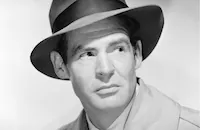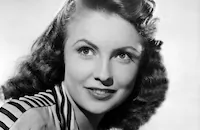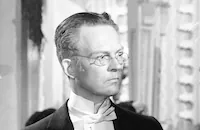Born to Be Bad

Brief Synopsis
Cast & Crew
Nicholas Ray
Joan Fontaine
Robert Ryan
Zachary Scott
Joan Leslie
Mel Ferrer
Film Details
Technical Specs

Synopsis
On the day that she is to host a society party for her artist friend, Gabriel "Gobby" Broome, Donna Foster, a publisher's assistant, is forced to deal with the early arrival of her boss John Caine's niece, Christabel. Christabel, who was reared by her poor maiden aunt, Clara Caine, in the small town of Santa Flora, has come to live with Donna in San Francisco and attend business college. When the fresh-faced Christabel meets Donna's fiancé, wealthy Curtis Carey, she immediately begins a fawning flirtation with him. In turn, aspiring novelist Nick Bradley, with whom Donna has been working, takes an instant liking to Christabel. Although Nick quickly observes that Christabel is "two people," a nice, unaffected girl, and an ambitious, cunning woman, he nonetheless continues to desire her. Later, Christabel, who has quit school, is having her portrait painted by Gobby when Curtis telephones, asking her to meet him at a jewelry store. Breaking a date with Nick, Christabel rushes to Curtis' side, but is disappointed to discover that he merely wants her advice on buying an engagement present for Donna. Christabel tries to convince Curtis to give the down-to-earth Donna a cheap cameo, but Curtis finally chooses an expensive sapphire-studded necklace. Donna is thrilled by the necklace until Christabel acts sweetly surprised that she would enjoy such a lavish gift. The now-fretful Donna later confides in Nick her concerns that Curtis may suspect her of marrying him for his money. Nick, whose first novel is about to be published by John, reassures Donna about her engagement, but at Gobby's art opening, Curtis confesses to Christabel his fears that Donna is becoming obsessed with his wealth. Acting the part of the concerned friend, Christabel suggests that Curtis draw up a pre-nuptial agreement with Donna. When Curtis mentions Christabel's idea to Donna, she is deeply hurt at his implied mistrust. Later that night, after Curtis insists on buying Christabel's portrait, Donna accuses Christabel of selfish subterfuge and reveals that her engagement has been broken. Seeing her opportunity, Christabel begs her now-suspicious uncle to allow her to stay in San Francisco long enough to attend a charity ball that Curtis is sponsoring. At the ball, Christabel acts guilt-ridden, then confesses her attraction to Curtis, who returns her affection. When Christabel tells Nick, who earlier had proposed to her, that she is marrying Curtis, he remarks that, despite his rival's wealth, she will never be satisfied with him. After a despondent Nick moves to Boston, Christabel and Curtis marry, and Christabel throws herself into her social duties, heading up charitable committees and planning balls. At the same time, Christabel connives to have Clara, who has been living with her since her marriage, shipped back to Santa Flora as she fears that the frail woman will discourage Curtis from spending money on her. Christabel's constant social activity causes Curtis to question her devotion to him, and, sensing that she is still interested in Nick, who has returned to San Francisco, he insists that they go together to a weekend resort. Although Christabel pretends to endorse Curtis' plan, she slips away from the resort as soon as possible, leaving a note claiming that Clara, who she knows is ill, needs her in Santa Flora. Instead, Christabel meets secretly with Nick to rekindle their romance. When Nick realizes that Christabel wants only to have an affair with him, however, he denounces her as incurably selfish. Rejected by Nick, Christabel returns home, only to be caught in her lies by Curtis and John, who reveals that Clara died earlier that afternoon. His eyes finally opened, Curtis demands that Christabel leave with only a few furs to her name. While speeding away from the house, Christabel crashes her car and ends up in a hospital. She soon becomes involved with her surgeon, whose wife sues her for alienation of affection. Later, after Curtis and Donna reunite, Christabel sees a lawyer about the lawsuit and, as indicated by the rising price tag on her portrait, causes yet another juicy scandal.

Director

Nicholas Ray
Cast

Joan Fontaine

Robert Ryan

Zachary Scott

Joan Leslie

Mel Ferrer

Harold Vermilyea
Virginia Farmer
Kathleen Howard
Dick Ryan

Bess Flowers
Joy Hallward
Hazel Boyne

Irving Bacon

Gordon Oliver
Sam Lufkin
Helen Crozier
Bobby Johnson
Tim Taylor
Ray Johnson
John Mitchum
Evelyn Underwood
Peggy Leon
Homer Dickinson
Georgianna Wulff
Ann Burr
Frank Arnold

Don Dillaway
Avery Graves
Jack Chefe
Barry Brooks
Al Murphy
Crew
C. Bakaleinikoff
Gordon Bau
Orville Beckett
Fred Bentley
Phil Brigandi
Hattie Carnegie
Tom Clement
Albert S. D'agostino
Ruby Felker
Fred A. Fleck
Frederick Hollander
Alex Kahle
Frederic Knudtson
Stan Margulies
Harley Miller
Nicholas Musuraca
Jack Okey
George Oppenheimer
William Phillips
Clem Portman
Sid Rogell
Charles Schnee
Darrell Silvera
Robert Soderberg
Edith Sommer
Robert Sparks
Ernst Van Leyden
Mercy Weireter
Hagar Wilde
Michael Woulfe

Photo Collections
Videos
Movie Clip




Trailer
Hosted Intro
Film Details
Technical Specs

Articles
Born to Be Bad (1950)
Actress Joan Fontaine had bought the rights to the novel, then sold them to RKO. Born to Be Bad was scheduled to go into production in 1946, was put on hold twice, and had gone through seven screenwriters when it finally went into production early in 1949. By that time, Hughes had bought the studio. According to Fontaine, he had been proposing to her for ten years (he had also wooed Fontaine's sister, Olivia de Havilland), and now he continued his pursuit. By that time, Fontaine's marriage to producer William Dozier was rocky, and in her memoirs she implied that when she told her husband about Hughes' latest proposal, the two of them decided that she would agree to divorce Dozier and marry Hughes if he hired Dozier to run the studio. Fontaine wrote that she was not in love with Hughes, and was unwilling to have an affair with him before she was divorced, because she did not want to risk losing custody of her daughter. So negotiations broke down, the relationship with Hughes never went anywhere, and Fontaine's marriage eventually ended. Dozier, however, did end up working at RKO. As for Born to Be Bad, Fontaine writes that "the only acceptable part of the film was my wardrobe designed by Tina Leser." (Fontaine's costumes are credited to New York couturier Hattie Carnegie.)
The rest of the cast included former Warner Brothers ingenue Joan Leslie, giving a strong performance as the discarded fiancee, and Zachary Scott as the rich man who becomes Christabel's prey. Mel Ferrer, recently signed by Hughes to a contract, played an artist who paints Christabel's portrait and observes her villainy. Ferrer was also a writer and director, and his second directorial effort, The Secret Fury (1950), was released in the same year as Born to Be Bad. Ferrer was also the fifth and only credited director on the Hughes fiasco, Vendetta (1950).
Director Nicholas Ray insisted on Robert Ryan for the part of the novelist who falls in love with Christabel. Born to Be Bad was the first of five films Ray and Ryan made together, and the start of a lasting friendship. Ryan's rugged good looks and ability to portray complex and often conflicting emotions made him an ideal Ray protagonist. His performance as the troubled cop in Ray's film noir On Dangerous Ground (1952) is one of Ryan's best.
Born to Be Bad was the fourth film directed by Ray, who had made an auspicious debut the previous year with the powerful They Live by Night (1949). Already, though, Ray had demonstrated a strikingly original visual style, and an ability to convey emotional intensity even when working with the most banal material. The opening scenes in Born to Be Bad are a bravura exercise in style, as he introduces the main characters preparing for and attending a party at the apartment of Leslie's character. The brilliantly choreographed and lit movement through the apartment hallway with many doors leading off it provides a visual metaphor for the characters' tangled relationships. The work of cinematographer Nicholas Musuraca, who had been working in films since the early 1920s, and whose work on Out of the Past (1947) helped define film noir, is stunning in this sequence.
As was becoming typical of Ray's working method, he agonized over every scene of Born to Be Bad, which producer Robert Sparks was treating as just another romantic melodrama. After the film was finished, Hughes, typically, began tinkering. He ordered reshoots with other directors. He changed the ending. Ray asked for the right of final cut, but was denied. Somehow, an ending without retribution for Christabel managed to slip past the censors. When the film was finally released, critics dismissed it as just another soap opera. But over the years, as the cult of Nicholas Ray has grown, Born to Be Bad has undergone a critical re-evaluation. Franklin Jarlett, in his book on the life and career of Robert Ryan, writes "Born to Be Bad was well-written, fast paced, and convincingly played....In Nicholas Ray's perceptive hands, it emerged as a morality play." Born to Be Bad even received the ultimate movie lovers' accolade, when it was parodied on the Carol Burnett TV show, as "Raised to Be Rotten."
Director: Nicholas Ray
Producer: Robert Sparks
Screenplay: Edith Sommer, based on the novel, All Kneeling by Anne Parrish; adaptation, Charles Schnee, additional dialogue, Robert Soderberg, George Oppenheimer
Cinematography: Nicholas Musuraca
Editor: Frederic Knudtson
Costume Design: Hattie Carnegie, Michael Woulfe
Art Direction: Albert S. D'Agostino, Jack Okey
Music: Constantin Bakaleinikoff
Principal Cast: Joan Fontaine (Christabel), Robert Ryan (Nick Bradley), Zachary Scott (Curtis), Joan Leslie (Donna), Mel Ferrer (Gobby), Harold Vermilyea) Virginia Farmer (Aunt Clara).
BW-90m. Closed captioning.
by Margarita Landazuri

Born to Be Bad (1950)
Quotes
Trivia
The film had two endings. Director Nicholas Ray raised the issue of a director's right to final cut, and at this time the collective contract with directors did not stipulate this right.
Notes
Working titles for this film were Christabel Caine, All Kneeling and Bed of Roses. As indicated in the file on the film in the MPAA/PCA Collection at the AMPAS Library, two endings were shot for the film. In the first version, which was submitted for PCA approval on September 13, 1949, the picture concludes when "Christabel" leaves "Curtis'" house with only a few furs. The second ending, which was submitted for approval on August 8, 1950, included the scene in which "Donna" and "Curtis" reunite, as well as the car crash scene and subsequent scandal scenes. Although the second ending appears to have been used in 1950 release prints, the first ending was seen in the viewed print. Gordon Oliver's cast credit was not included in the viewed print, but was listed in a 1950 cutting continuity deposited with the copyright records.
The PCA file also indicates that, although early drafts of the story were approved by the Breen Office, later versions caused objections because of the "implication of illicit sex which is treated without the proper compensating moral values." Although no significant changes were made in the story, the script was finally approved in June 1949, as was the revised ending in August 1950. In a September 13, 1950 letter to PCA director Joseph I. Breen, however, Martin Quigley, the influential, conservative president of Quigley Publishing Company, complained that the revised ending, which he noted was ordered by RKO head Howard Hughes, was morally unacceptable because the "dame" is not punished, but is seen "nicely getting away with it." In response, Breen reassured Quigley that his office and RKO were headed for a "grand crash." In addition, in November 1949, Variety reported that because of pressure from the National Legion of Decency, RKO withdrew its foreign version of Born to Be Bad, which the Legion considered to be "more morally offensive" than the domestic version, and replaced it overseas with the domestic version. Modern sources note that the reunion scene between Donna and Curtis, which takes place after Curtis is seen flying by himself in a small airplane, was rewritten by Hughes. Modern sources also claim that while Nicholas Ray directed some of the rewritten material in 1950, Robert Stevenson reshot the hospital scene and Richard O. Fleischer directed the scene in the prison hospital.
Contemporary news items add the following information about the production: Pre-production on the picture began in late 1945. At that time, William Pereira was to produce the film, and Paul Stewart was to direct it. Alan Marshal, who was to be borrowed from David O. Selznick's company, was slated to co-star with Joan Fontaine, and Marsha Hunt, a featured player at M-G-M, was to have a supporting role. In mid-January 1946, Stewart was removed as director, and John Sutton was hired to replace Marshal. Paramount director John Berry was hired in late February 1946, and Henry Fonda was announced as Fontaine's new co-star in mid-March 1946. According to modern sources, Edmund Goulding, John Hambleton and Shepard Traube were also assigned to direct before Ray was finally chosen in May 1949.
Modern sources also note that in 1948, RKO contract star Gloria Grahame was being considered for the film's lead, but was rejected by studio head Howard Hughes, who then ordered an indefinite delay in production. Modern sources also claim that Barbara Bel Geddes was considered for the title role. In addition to Marshal and Sutton, other male leads under consideration were Ronald Reagan, David Niven, Dan Duryea, Vincent Price, George Sanders and Franchot Tone, according to modern sources. RKO borrowed Zachary Scott from Warner Bros. for the production. Joan Leslie returned to the screen after a two-year absence to co-star in the film. According to Los Angeles Times, the portraits seen in Born to Be Bad were painted by Ernst Van Leyden, who also was a technical advisor on the picture. Wood sculptures, which were also featured in the film, were created by "GI-bill students" Jack Horton and Bennett Wade, according to the same item.
According to modern sources, Hughes's action in regard to this film contributed to RKO production chief Dore Schary's decision to leave the studio. Modern sources give the following additional credits: Dir of photog for addl scenes: Clifford Stine, Harry J. Wild and Robert de Grasse; Sd for addl scene: Earl B. Mounce; and Dialogue Director: Rodney Amateau. Additional cast members from modern sources include Jane Hedges (Lawyer's secretary), Sam Harris (Old man at ball), J. Park, M. Russell, John Holland, Russell Fillman, Perc Launders, Stan Holbrook and Ted Cooper.

Miscellaneous Notes
Released in United States Summer July 15, 1950
Released in United States Summer July 15, 1950















